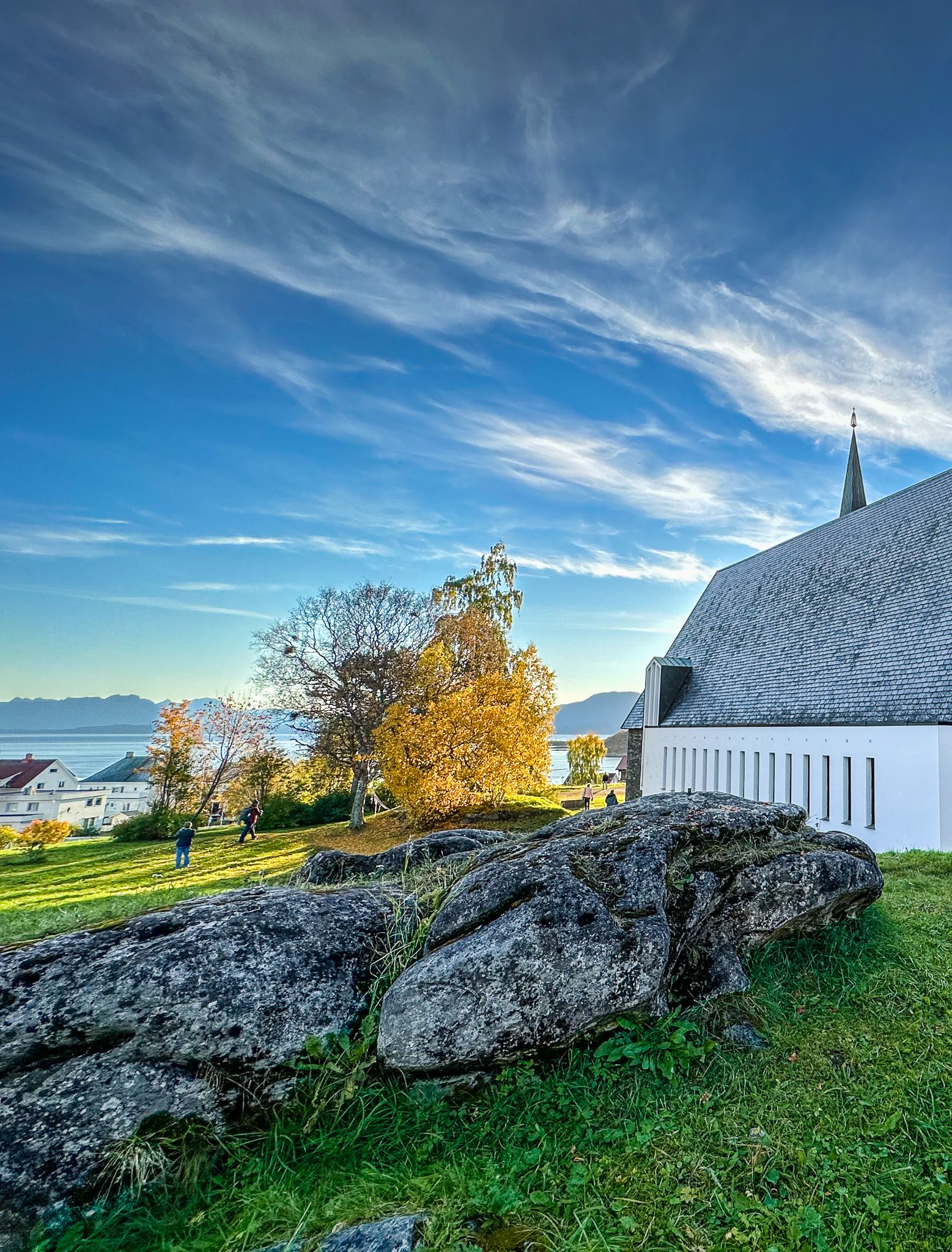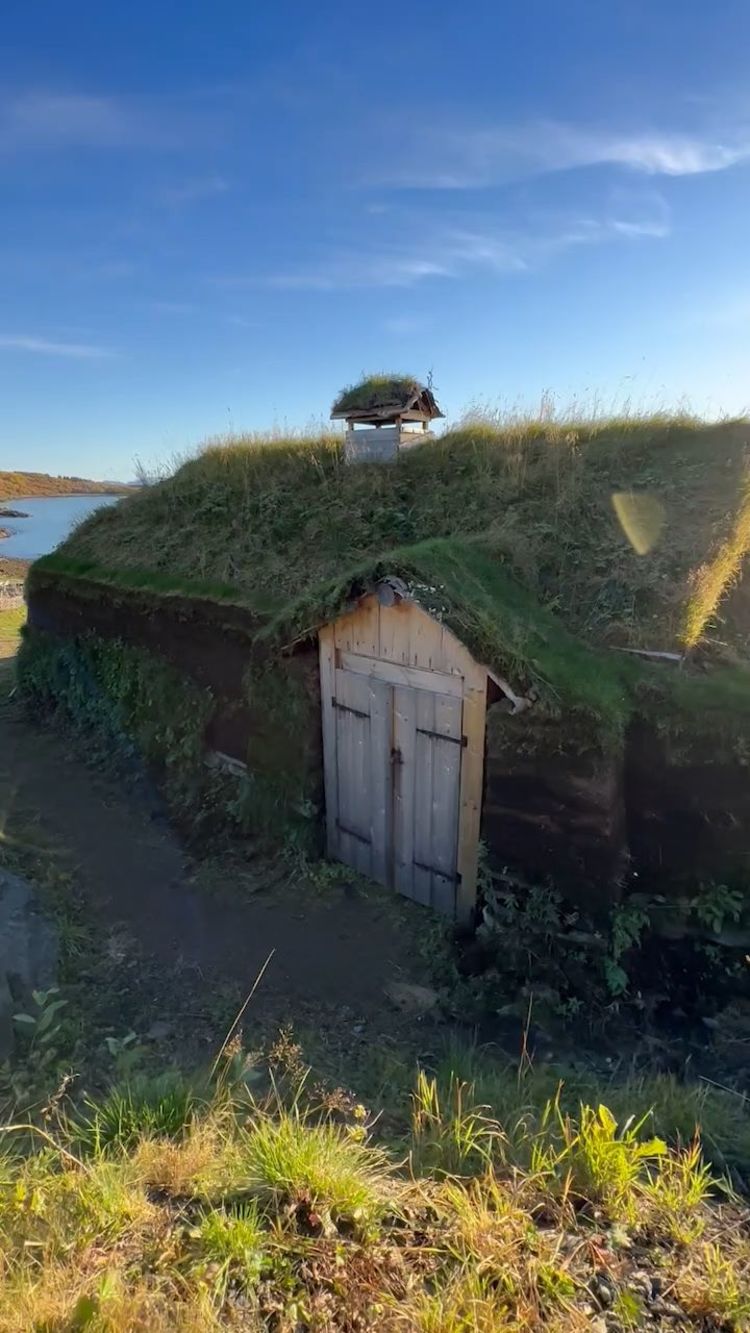A Taste of Vesterålen
↓

A Taste of Vesterålen
↓

This may just be a small piece of Norway, but the impressions I now have of this stunning area, so enriched by its culture and history, will stay with me forever.
“At first, there was nothing here. Then, the herring appeared, so the fishermen followed, and we all know that where the fishing is good, society grows”.
This is among the first information our tourist guide, Torstein Apenes, shares with us as we leave the harbour of Harstad this early late-September morning.
“Towards the end of the 19th century, this was a city of about 20,000 inhabitants”, the guide continues as our bus heads for our first stop on this popular excursion through the spectacular Vesterålen of the north. (Usually, we would have visited Trondenes Church instead, but that building is currently being renovated).

Tourist guide Torstein Apenes.
Tourist guide Torstein Apenes.
As we step outside the bus to take a closer look at Harstad Church, built in 1958, it strikes me that we could not have chosen a better day to explore this area. The trees are wrapped in the colours of the autumn, and in the shining light from the morning sun, the leaves glow like coloured glass.
As we step outside the bus to take a closer look at Harstad Church, built in 1958, it strikes me that we could not have chosen a better day to explore this area. The trees are wrapped in the colours of the autumn, and in the shining light from the morning sun, the leaves glow like coloured glass.

Harstad Church

On a small mound close to the church, stands a statue resembling the priest Hans Paolsen Egede (b. 1686-1758).
Egede is feasibly best known for his efforts to Christen the Inuit of Greenland, and he is often referred to as “The Apostle of Greenland”. Did he succeed? This is debatable; when three more priests were sent to Greenland to help Egede with his missionary work in 1733, the ship that brought them also carried smallpox. The epidemic spread with tremendous speed, killing about one third of the population along the Greenland coast. Even Egede’s wife died from the disease.
Before all this happened, Hans Egede worked as chaplain in Vågan, Lofoten. However, he was born in Trondenes in the municipality of Harstad, which is why this statue is erected here.
On a small mound close to the church, stands a statue resembling the priest Hans Paolsen Egede (b. 1686-1758).
Egede is feasibly best known for his efforts to Christen the Inuit of Greenland, and he is often referred to as “The Apostle of Greenland”. Did he succeed? This is debatable; when three more priests were sent to Greenland to help Egede with his missionary work in 1733, the ship that brought them also carried smallpox. The epidemic spread with tremendous speed, killing about one third of the population along the Greenland coast. Even Egede’s wife died from the disease.
Before all this happened, Hans Egede worked as chaplain in Vågan, Lofoten. However, he was born in Trondenes in the municipality of Harstad, which is why this statue is erected here.
Not far away, lies the living museum, Trondenes Middelaldergård (the mediaeval farm of Trondenes), which is a reconstructed farm complex showing life in Trondenes around the year 1200, i.e. approximately 200 years after the age of the Vikings.

We are greeted by a museum educator, Mona Høydal.
She informs us that most of what we see on the farm is built in the same way as it was done during the Middle Ages, with copies of tools used in the 13th century. Even the farming itself is carried out in a proper old-fashioned way; at least as far as the knowledge of the museum employees goes and as long as it’s practically possible.
“We have constructed an ‘årestue’. We built it because traces of an ‘årestue’ just like this one were found in archaeological excavations here in Trondenes”, says Høydal.
The årestue is made of wood, with bark on the roof and sod on the entire outside. This is how people of the north have insulated their houses for hundreds of years.
Cooking, eating, repairing, making clothes, sleeping… All parts of the indoor life took place in this single room.

Cooking, eating, repairing, making clothes, sleeping… All parts of the indoor life took place in this single room.
Cooking, eating, repairing, making clothes, sleeping… All parts of the indoor life took place in this single room.
During the summer, Høydal and the rest of the employees at the farm grow nettle and flax. That’s because the fibres in these plants are so strong that they can be used in yarn, clothing, and tools.
“You cannot tear a single straw into pieces with your bare hands, it’s too strong”, she says.
In the mediaeval times, flax was used to make clothes, but it was also handy as sewing thread, especially when sewing leather or making fish nets or ropes.
“This season, our flax has not reached its necessary length though, so unfortunately it’s completely useless to us”, says Høydal, who believes the bad crops were the result of too much bad weather during the recent summer.
“So, we figured that we could use nettle instead, as its fibres are almost as strong as the ones of the flax. But as you can imagine, nettle is not very comfortable on your skin, so it’s not suitable for clothing. However, it’s perfect for producing tools and equipment”, she explains.
A few weeks before our arrival at the medieval farm, the museum invited the locals of Harstad to pay the entrance fee in nettles.
“Many people, especially families with children, collected the plants in their gardens and then came to spend a day at our museum. Their harvests will be used to produce tools this winter”.
The farmers at the complex also grow food, such as grain, barley, oats, parsnips, turnips, onions, and herbs.
“In the Middle Ages, herbs were used both as flavouring and as medicine”, says the museum educator.
This church was added to the farm in June 2021. It is an authentic copy of the Haltdalen Stave Church in Trondheim, which is the smallest of the 28 remaining stave churches in Norway.

This church was added to the farm in June 2021. It is an authentic copy of the Haltdalen Stave Church in Trondheim, which is the smallest of the 28 remaining stave churches in Norway. “We built the church because the saga tells that King Øystein Magnusson – brother of Sigurd Jorsalfare – said that a church should be built at Trondenes”, says Høydal.
This church was added to the farm in June 2021. It is an authentic copy of the Haltdalen Stave Church in Trondheim, which is the smallest of the 28 remaining stave churches in Norway. “We built the church because the saga tells that King Øystein Magnusson – brother of Sigurd Jorsalfare – said that a church should be built at Trondenes”, says Høydal.
“We built the church because the saga tells that King Øystein Magnusson – brother of Sigurd Jorsalfare – said that a church should be built at Trondenes”, says Høydal.
At the very top of the property sits a forge with a lovely view overlooking the sea, the forest, and the mountains. It was common to place the forge at some distance from the rest of the buildings on the farm due to the risk of fire.

After enjoying the beautiful surroundings of the outdoor museum, we have time for a visit with Trondenes Historical Centre next door. Here, we get to see several very interesting exhibitions and learn a lot about the region’s history, from Stone Age until the 1950’s, with the main emphasis on the age of the Vikings, The Mediaeval times, and the Second World War.
* You may wonder why Northern Norway, far from Central Europe, was so involved in Wordl War II. One explanation is that the Nazi Germany (1933-1945) wanted to secure a supply of iron ore to produce steel for armour and weapons, of which there was plenty in Narvik in Nordland County. Large quantities of iron ore from two Swedish mines, Kiruna and Gällvare, were shipped there. In addition, Adolf Hitler wanted to control the Norwegian airport at Bardufoss.
The British were aware of the Germans’ aims, and therefore intervened to cut off the steel supply. This resulted in one of WWII’s first major battles taking place in Narvik – for two months from April to June 1940.
Furthermore, Hitler considered Northern Norway as an “area of destiny” throughout the war, which is why the area contains many traces of this gloomy chapter in Norwegian history.
We experience a lot of beautiful nature and exciting sites through the windows of the bus as well, and along the way, Torstein is eagerly telling us a bit about Norwegian History and culture, as well as the geography, climate, and business life of the region.
For instance, we drive past a salmon farm…

…and a strawberry farm.

“The people who run this strawberry farm have become very rich”, says the guide.
Northern Norway is known for its naturally sweet strawberries. The flavour is a result of the midnight sun, which allows the photosynthesis to work “around the clock” throughout the summer.
“But who are to pick all the strawberries? It could have been a nice job for our youngsters, but they are too lazy to do it”, says Torstein, and although we sense his smile as he speaks, we do not doubt the seriousness in his statement.
He continues:
“You see, people from the Baltic countries come here to work during the strawberry season, and they seem to enjoy it. It’s a “win-win-situation” because the owners of the farms get the job done, while the seasonal workers get to go back home with their pockets full of money”.
The tour includes a ferry ride – the whole bus gets on it – and once we arrive on the inside deck, 33 cups and just as many samples of waffles with brown cheese and lefse (Norwegian flat cake) with butter, sugar and cinnamon await us.
A group of Swiss visitors offer me a seat at their table. It turns out that they are part of a tour group of 20 people. They travelled by train from Oslo to Bergen, where they boarded Havila Castor. They have now been all the way up to Kirkenes and are on their way back down to Trondheim. From there, they will catch a train back to Oslo.
“We have had a very nice journey so far. For me, the highlight was probably the North Cape Plateau. I’ve been there once before as well – in 2009, says Eric.

Here he is (on the left) with Verena, Monika, Manfred, and Pia.
Here he is (on the left) with Verena, Monika, Manfred, and Pia.
We do make a couple of pure photo stops during the excursion. This area is a definite favourite!
At last, we reach Sortland (meaning ‘black land’), also referred to as “The Blue Town”. As we drive across the near one-kilometre long Stortland Bridge, we see the Havila Castor pass beneath us.
Soon after, the bus parks at the port of Sortland, and we board the ship once again.
Today, I have seen and learned a lot, and now I fully understand why this is one of Havila Voyages’ most popular excursions. Fortunately, it runs all year round.
You can learn more about this excursion here.
Text and photo/video: Josefine Spiro
